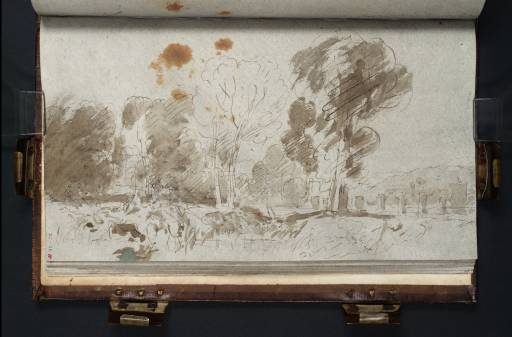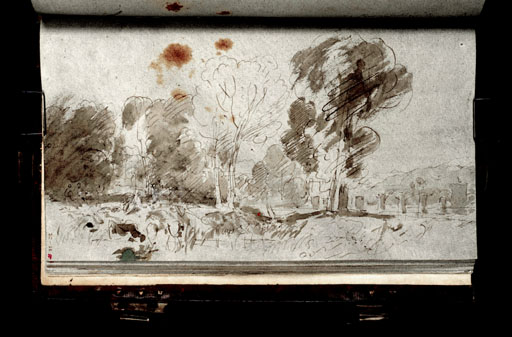Joseph Mallord William Turner Study for a Landscape with a Ruined Roman Bridge: ?Pan and Syrinx 1805
Image 1 of 2
Joseph Mallord William Turner,
Study for a Landscape with a Ruined Roman Bridge: ?Pan and Syrinx
1805
Joseph Mallord William Turner 1775–1851
Folio 55 Recto:
Study for a Landscape with a Ruined Roman Bridge: ?Pan and Syrinx 1805
D05577
Turner Bequest XC 55
Turner Bequest XC 55
Pen and ink and brown and grey washes on off-white wove paper, prepared with a grey wash, 150 x 258 mm
Inscribed by John Ruskin in red ink ‘55’ bottom left, descending vertically
Stamped in black ‘XC 55’ bottom left, descending vertically
Inscribed by John Ruskin in red ink ‘55’ bottom left, descending vertically
Stamped in black ‘XC 55’ bottom left, descending vertically
Accepted by the nation as part of the Turner Bequest 1856
References
1909
A.J. Finberg, A Complete Inventory of the Drawings of the Turner Bequest, London 1909, vol.I, p.236, XC 55, as ‘Study for a landscape with classical figures’.
1984
Martin Butlin and Evelyn Joll, The Paintings of J.M.W. Turner, revised ed., New Haven and London 1984, p.118.
1990
Andrew Wilton and Rosalind Mallord Turner, Painting and Poetry: Turner’s ‘Verse Book’ and his Work of 1804–12, exhibition catalogue, Tate Gallery, London 1990, p.124.
1993
David Hill, Turner on the Thames: River Journeys in the Year 1805, New Haven and London 1993, p.162.
1996
Gillian Forrester, Turner’s ‘Drawing Book’: the Liber Studiorum, exhibition catalogue, Tate Gallery, London 1996, pp.48, 49 note 2, 144 note 5.
This is one of two versions of a wooded river landscape with a ruined Roman bridge in the right middle distance, the scenery of which seems to be based on this sketchbook’s various views of the Thames at Kew; the other is folio 56 (D05579). These have variant foregrounds, probably with ideas for episodes from Ovid’s Metamorphoses; see note to folio 54 (D05575) for Ovidian subjects in the sketchbook. In his note to folio 54, Hill describes the present study as depicting Pan and Syrinx, from Book 1 of the Metamorphoses.1 Pursued by the god Pan to the shady banks of the Arcadian River Ladon, Syrinx was transformed into reeds to escape his advances, and Pan bound the reeds together with wax to form his pipes; Mercury lulled Argus to sleep by telling him their story, before slaying him and releasing Io (then in her guise as a heifer) from captivity. Hill’s identification is convincing as there is a cow in the left foreground, and two figures behind it, while pen strokes by the water in the foreground would represent reeds. Moreover, ‘Pan and Syrinx’ is noted with other subjects from the Metamorphoses on folio 55 verso (D05578). However, in describing 55 recto, Hill suggests only ‘an incident from the life of Io’.
Turner made Pan and Syrinx the subject of one of his unpublished plates for the Liber Studiorum and its source in his ‘Arcadian interlude in Isleworth’ – that is, in this sketchbook – is noted by Gillian Forrester,2 along with the unfinished, contemporary oil Willows Beside a Stream (Tate N02706) whose similarly sylvan background was observed by Butlin and Joll.3 Butlin and Joll also recognised that the present drawing and folio 56 provided the source for another unfinished oil in the same series, Trees beside the River, with Bridge in the Middle Distance (Tate N02692).4
Forrester sees the diffusion of this composition into another very Claudean Liber plate, Woman with Tambourine, as further evidence that the drawings in this sketchbook were made ‘with classical themes in mind’.5
Forrester sees the diffusion of this composition into another very Claudean Liber plate, Woman with Tambourine, as further evidence that the drawings in this sketchbook were made ‘with classical themes in mind’.5
Butlin and Joll, and also Hill, remark another drawing of a very similar landscape, but lacking the Italianate ruined bridge, in the Wey, Guildford sketchbook (Tate D06194; Turner Bequest XCVIII 10).
David Blayney Brown
August 2007
How to cite
David Blayney Brown, ‘Study for a Landscape with a Ruined Roman Bridge: ?Pan and Syrinx 1805 by Joseph Mallord William Turner’, catalogue entry, August 2007, in David Blayney Brown (ed.), J.M.W. Turner: Sketchbooks, Drawings and Watercolours, Tate Research Publication, December 2012, https://www


